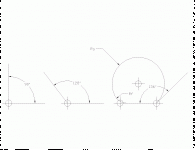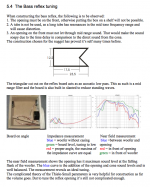Sorry Graham, I do mot want to sound harsh, but that is definitely not an example of a well finished sphere. It lacks the most import property of a well designed sphere, that is an ultra smooth transition from driver to enclosure. Basically there should be no flat surface surrounding the driver(s).
From the looks of it, the Sophera has a "hard" transition from a flat baffle to the sphere.
Eelco
Exactly. The sharp edge transition around the flat area where the drivers are located should be eliminated as much as possible. It's creating diffraction. This is also the problem I have with the small commercial "egg" speaker that user whgeiger posted about.
In order to eliminate a diffracting edge as much as possible I am proposing to make the sphere much larger. I proposed making it at least 4-5 times larger in diameter than the diameter of the largest driver. If the speaker in the sphere is a 2-way, a high quality 5" driver can be used with a 24" or larger sphere. Even if a small tweeter is used the mid and tweeter can't be in a "flat" because that would be almost 10" across, and this is almost HALF of the diameter of the sphere. So either a small blob for the tweeter must be added on to the sphere or the MW and T can be mounted so that they point away from each other by 20 degrees, but each is mounted in their own "flat" area that is tangential to the sphere. Alternately the large "sphere" shape can be elongated along the line connecting the MW and T, like two merged spheres with centers separated by the same distance as the separation of the MW and T. If you make the upper sphere smaller in diameter you start to approach a large egg shape. Having a large curvature is really the key to achieving a smooth transition from driver edge to cabinet. It's just not possible in a small cabinet.
I disagree with #3, and don't think that these will ring. Concrete walls make a very good sound barrier, as they do not get excited, nor transmit sound.
I've a pair of Rauna of Sweden Leira II speakers, which are some of the rare commercially successful (in Sweden) concrete speakers to have been made. With three-quarter inch side walls poured around a stryofoam mold core to form a two-way, transmission line floorstander, they're surprisingly good sounding little oddballs. The cabinets rank among some of the best of what I have here in terms of materials, but, real world experience here: they do ring and once they start ringing, it's loud and long. It's noticeable with the knuckle rap, but also with music when loud transients hit the right frequencies. I'd put them third behind heavily braced, double thickness 3/4" Appleply boxes (high end birch and maple ply) and some funky poly resin cabinets (dead, dead things) in comparison of what I have here. They'd be first if only they were better damped, but strong concrete rings without something to address it.
Edge Difraction Diminishes when ...
1) the angle between adjoining surfaces approaches 180°.
2) an edge round-over is introduced with a radius that is greater than 1/8 the wave length of the lowest frequency that marks the onset of the response ripple.
Given these facts, the overall radius of the enclosing sphere need not be increased as much as you suppose. The point of diminishing returns may be met long before under the conditions as set forth in 1) and 2) above.
WHG
Exactly. The sharp edge transition around the flat area where the drivers are located should be eliminated as much as possible. It's creating diffraction. This is also the problem I have with the small commercial "egg" speaker that user whgeiger posted about.
In order to eliminate a diffracting edge as much as possible I am proposing to make the sphere much larger. I proposed making it at least 4-5 times larger in diameter than the diameter of the largest driver. If the speaker in the sphere is a 2-way, a high quality 5" driver can be used with a 24" or larger sphere. Even if a small tweeter is used the mid and tweeter can't be in a "flat" because that would be almost 10" across, and this is almost HALF of the diameter of the sphere. So either a small blob for the tweeter must be added on to the sphere or the MW and T can be mounted so that they point away from each other by 20 degrees, but each is mounted in their own "flat" area that is tangential to the sphere. Alternately the large "sphere" shape can be elongated along the line connecting the MW and T, like two merged spheres with centers separated by the same distance as the separation of the MW and T. If you make the upper sphere smaller in diameter you start to approach a large egg shape. Having a large curvature is really the key to achieving a smooth transition from driver edge to cabinet. It's just not possible in a small cabinet.
1) the angle between adjoining surfaces approaches 180°.
2) an edge round-over is introduced with a radius that is greater than 1/8 the wave length of the lowest frequency that marks the onset of the response ripple.
Given these facts, the overall radius of the enclosing sphere need not be increased as much as you suppose. The point of diminishing returns may be met long before under the conditions as set forth in 1) and 2) above.
WHG
Last edited:
InterestingI've a pair of Rauna of Sweden Leira II speakers, which are some of the rare commercially successful (in Sweden) concrete speakers to have been made. With three-quarter inch side walls poured around a stryofoam mold core to form a two-way, transmission line floorstander, they're surprisingly good sounding little oddballs. The cabinets rank among some of the best of what I have here in terms of materials, but, real world experience here: they do ring and once they start ringing, it's loud and long. It's noticeable with the knuckle rap, but also with music when loud transients hit the right frequencies. I'd put them third behind heavily braced, double thickness 3/4" Appleply boxes (high end birch and maple ply) and some funky poly resin cabinets (dead, dead things) in comparison of what I have here. They'd be first if only they were better damped, but strong concrete rings without something to address it.
1) the angle between adjoining surfaces approaches 180°.
2) an edge round-over is introduced with a radius that is greater than 1/8 the wave length of the lowest frequency that marks the onset of the response ripple.
Given these facts, the overall radius of the enclosing sphere need not be increased as much as you suppose. The point of diminishing returns may be met long before under the conditions as set forth in 1) and 2) above.
WHG
Hmmm, something is not right with (1). How can an angle between adjoining surfaces approach 180 degrees? You are describing a sheet of paper! Maybe you mean "as the angle between adjoining surfaces approaches ZERO degrees"?
For Answer
see attachment. Approaching 0° would be like a knife edge.
WHG
Hmmm, something is not right with (1). How can an angle between adjoining surfaces approach 180 degrees? You are describing a sheet of paper! Maybe you mean "as the angle between adjoining surfaces approaches ZERO degrees"?
see attachment. Approaching 0° would be like a knife edge.
WHG
Attachments
Last edited:
see attachment. Approaching 0° would be like a knife edge.
WHG
Who describes this kind of thing by the INTERNAL angle???
Let me ask you this: do you have a 45 degree or a 135 degree beveled edge???
Why is this an Issue for you?
My description is clear regarding diffraction edges and how adjoining surfaces intersect to form them and contribute to acoustical diffraction.
BTW, a bevel has two diffraction edges and involves three surfaces that intersect in pairs to form them. Their dimension set is what determines the degree to which they are acoustically important.
WHG
Who describes this kind of thing by the INTERNAL angle???
Let me ask you this: do you have a 45 degree or a 135 degree beveled edge???
My description is clear regarding diffraction edges and how adjoining surfaces intersect to form them and contribute to acoustical diffraction.
BTW, a bevel has two diffraction edges and involves three surfaces that intersect in pairs to form them. Their dimension set is what determines the degree to which they are acoustically important.
WHG
Last edited:
Quick Reference
see: Diffraction from baffle edges
(Midway, 2nd. paragraph)
N.B.: For 'blunt' edges (where angle [a] between adjoining sides is 90° < [a] < 180°) the radius becomes less acoustically significant with 'bluntness' ([a] -> 180°).
Also, at the lower bound of the drivers passband, the edge is acoustically transparent. At the upper bound, the driver is illuminating the edge to a lesser degree as its output becomes directional.
Regards,
Bill
Hello WHG (Bill I presume?),
what is your source for 2) ?
Eelco
see: Diffraction from baffle edges
(Midway, 2nd. paragraph)
N.B.: For 'blunt' edges (where angle [a] between adjoining sides is 90° < [a] < 180°) the radius becomes less acoustically significant with 'bluntness' ([a] -> 180°).
Also, at the lower bound of the drivers passband, the edge is acoustically transparent. At the upper bound, the driver is illuminating the edge to a lesser degree as its output becomes directional.
Regards,
Bill
Charlie, how are you coming along on your molded enclosure plans?
Have you seen the efforts the designers of the 'Analog.on Nugget' spent on their cabinet?
Attached is just one page on the cabinet. They joke that the casing could be made of stone...
Foto Story
Have you seen the efforts the designers of the 'Analog.on Nugget' spent on their cabinet?
Attached is just one page on the cabinet. They joke that the casing could be made of stone...
Foto Story
Attachments
- Status
- This old topic is closed. If you want to reopen this topic, contact a moderator using the "Report Post" button.
- Home
- Loudspeakers
- Multi-Way
- Custom Concrete Speaker Cabinets

